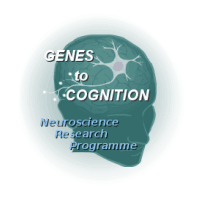G2C::Gene Targetting
Target Selection
Proteomic study of the composition of mammalian neuronal synapses has identified more than 1100 separate proteins localised at the synapse (Fig. 1) (16635246). Neurotransmitter receptor complexes, such as the N-methyl-D-aspartate receptor complex (NRC/MASC), are major components of the synaptic proteome (10862698). One major goal of our research programme is to understand the functional organisation of the signalling complexes at the synapse and their role in behaviour and disease.
We are using gene targeting technology to analyse the function of proteins expressed at the synapse and which form part of the MASC complex. Using this technology we can produce mutant mice lacking a gene of interest. These mice can be used in behavioural test to assess the contribution of a specific gene to learning and memory in an intact animal.
The initial targets selected were proteins which form part of the MASC complex, interacting synaptically localised proteins and potential disease gene candidates.
General Gene Targeting Methods
Gene targeting and generation of knockout mouse lines is performed largely according to standard protocols . Targeting vectors are constructed of a selectable marker and 2-5kb of homology on both sides (Fig. 2). Targeting vectors are designed to significantly impair the gene of interest by selecting important exons of the gene to be modified. These could be exons coding for the active site of an enzyme, or alternatively exons are deleted causing a frameshift in the transcript after removal. Targeting vectors are generated in the lab by recombination in E. coli using a modification of standard protocols (17426124; 12618378).
In brief, small homology arms are generated by PCR from a BAC containing the gene of interest and are cloned into pTargeter (Fig. 10). The modified pTargeter is linearised by restriction digest and electroporated into EL350 E.coli containing the BAC of interest. Recombination results in 8-15kb of the genomic sequences of the gene of interest cloned into pTargeter. Simultaneously small homology arms corresponding to the DNA sequences to be modified are cloned into a selectable marker plasmid such as pIRESlacZneoflox (Fig. 13). The modified pIRESlacZneoflox is introduced into EL350 cells containing the modified pTargeter. Recombination results in the selectable marker being inserted into the gene of interest in pTargeter and the targeting construct is now complete.
Constructs are subsequently electroporated into E14Tg2a embryonic stem cells, originally derived from 129P2 mice (Fig. 3). After electroporation cells are selected and individual colonies are isolated (Fig. 4). Genomic DNA from individual clones is screened by Southern blot or PCR for appropriate gene targeting. Importantly these probes or PCR primers are located outside the homology arms of the targeting vector. Example data for the generation and analysis of the Dlg3 mutant mouse is shown in Figure 5. After checking that recombination is appropriate, embryonic stem cells carrying the desired genetic modification are injected into blastocysts (Fig. 6). The resultant chimeras are then bred to generate a transgenic line (Fig. 7). Intercrossing of transgenic offspring can generate knockout mice deficient in the targeted gene (Fig. 8). The absence of the targeted gene protein product can be demonstrated by western blotting (Fig. 5).
Generation of specialised alleles
As well as generating our own mouse lines we also make use of mouse lines generated by other researchers as well as high throughput gene targeting and gene trapping resources which produce both targeted and conditional mutations.
In addition specialised types of alleles not generated by high throughput projects listed above. These include point mutations to make single amino acid changes in the targeted protein (Fig. 9). Other types of vectors allow modification of by insertion of protein tags, such as TAP tags, which allow the protein product of the gene of interest to be purified (Fig. 10).
G2C Programme targeting vectors
- pTARGETER (Fig. 11)
- pNeoflox (Fig. 12)
- ploxPneoflrt (Fig. 13)
- pIRESlacZneoflox (Fig. 14)
Selected G2C mouse lines
- Dlg4 (17046693; 14980210; 12593798; 9853749)
- Syngap1 (16452659; 12427827; 15673435)
- Hras1 (12427827)
- FAK (16768796; 17242067; 15601818)
- Dlg3 (17344405)
Gene targeting resources
References
-
nagy -year 2003 -isbn 978-0879695910 -author Nagy A -title Manipulating the mouse embryo : a laboratory manual, 3rd Ed -journal Cold Spring Harbor Laboratory Press, Cold Spring Harbor, NY
